The most distinct and important structure in Bhutan, Dzongs (fortresses) are architectural masterpieces that dotted Bhutan. Each Dzongs are built on a site chosen for religious significance.
Bhutanese dzong architecture reached its zenith in the 17th century after the arrival of the great lama Zhabdrung Ngawang Namgyal. Each of the dzongs site were based on omens and visions. The dzongs were well sited with regard to their function as defensive fortresses. Hilltops or mountain spurs were usually chosen as a site to build dzongs, and if dzongs were built on the side of a valley wall, a smaller dzong or a watchtower is typically built directly uphill from the main dzong whose main purpose would be to keep the slope clear of attackers who might otherwise shoot downward into the courtyard of the main dzong below.
The Dzongs are part of a network that defended the Kingdom against frequent invasions by Tibetans in the 17th century. Dzongs have stone foundations and walls of sand and clay bricks, and wooden beams are skillfully cut to fit most dexterously.
By tradition, dzongs are constructed without the use of architectural plans hence there is no blueprints of any of the dzongs. Instead a high lama who established each dimension by means of spiritual inspiration gave construction directions. Traditional Bhutanese architecture did not use any nails or iron bars. Dzongs serve as the religious, military, administrative and social centres of their districts and are often the site of an annual tsechu or other religious festivals.
DZONGS IN BHUTAN
Deprecated: Function create_function() is deprecated in /home/btravel/domains/4btravels.com/public_html/wp-content/plugins/contact-form-7/includes/formatting.php on line 53
18 FAMOUS DZONGS IN BHUTAN
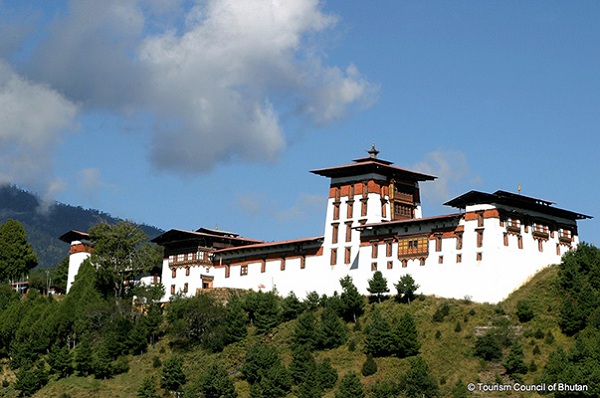
Jakar Yugyal Dzong, commonly known as Jakar Dzong, is situated on a ridge above the Jakar village of Chamkhar valley in Bumthang.There are different accounts of the origin of the Dzong. Some believe that the Dzong was built by Lam Ngagi Wangchuk (1517 – 1554) who came to Bhutan to spread the teachings of the Drukpa Kagyupa Buddhist order. It is said that a white bird perched on where Jakar Dzong was situated. This is considered an auspicious sign. According to the oral legend, a group of Lamas and elders were considering moving a fort, which was situated, at the eastern site of the Bumthang Valley. As they are sitting down to discuss, a bird, presumed to be the king of geese rose into the air and rested on a spur. The location was subsequently chosen for the present location of Dzong.
Thrice the Tibetan army attacked the Dzong. In the 17th century, the ruler of Tsang in Tibet, Phuntsho Namgyel, sent an army twice to destroy Zhabdrung. In 1679, the previously defeated chieftain of Bumthang Chokhor raised a Tibetan army and attacked the Dzong. The defenders sought the help of the protecting deities, Choe Chhong Chamdal Sum. The prayer was answered when the gun mounted on the sills, the legend says, aimed itself towards the enemy camp and fired all by itself, killing two important Tibetan commanders. Since this victory, the Dzong came to be known as Jakar Thobgyal (gyal-vicoty).
The third invasion happened under the reign of the 3rd Desi, Minjur Tempa. The difficult battle was only won with the arrival additional forces under Lam Ngawang Rabten. After this victory, the Dzong was renamed as ‘Jakar Yugyal Dzong’ meaning Victorious Fortress of the White Bird. The name Jakar and Yugyal were later merged to form the name Jakar Yugyal Dzong.
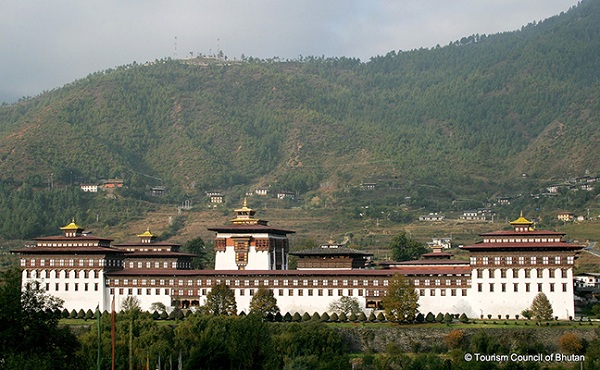
Known as “fortress of the glorious religion”, Tashichoe Dzong is an impressive structure that houses the Bhutanese government and stand on the right side of the Wangchu (Thimphu) River.The Dzong originated with the building of Dho-Ngon (Blue Stone) Dzong on a hill above Thimphu River where Dechenphodrang stands by Lama Gyalwa Lhanangpa. On the 17th century, the followers of Lama Gyalwa Lhanangpa were completely crush by Zhabdrung Ngawang Namgyal and the the Dho Ngon Dzong fell into the hands of Zhbdrung.Zhabdrung rebuilt the fortress in 1641 and renamed it Taschicho Dzong (Fortress of the auspicious religion).
In 1694, the 4th Desi Tenzin Rabgye enlarged the Dzong. The Dzong caught fire in 1698 and was restored. In 1747, the Dzong was enlarged at the initiative of the 13th Desi, Chogyal sherab Wangchuk. The Dzong caught fire again under the reign of the 16th Desi, Sonam Lhendup, and 13th Je Khenpo, Yonten Thaye. After this fire, the Dzong was relocated to the present location.
His Late Majesty Jigme Dorji wangchuck took the initiative of renovating the Dzong in 1962. The entire Dzong was rebuilt in traditional fashion, without nails or written plans. Zopen Parpa Yodsel oversaw the overall renovation works. In 1969, the earth Bird year, the Dzong was consecrated by Je Khenpo Thri Zur Thinley Lhendup, and Dorji Lopon Nyizer Tulku.
In the past, the national Assembly met within the Dzong. Today, it houses the secretariat, throne room, and offices of King of Bhutan. The northern portion is the summer residence of the Je Kehnpo and the Central Monastic Body.
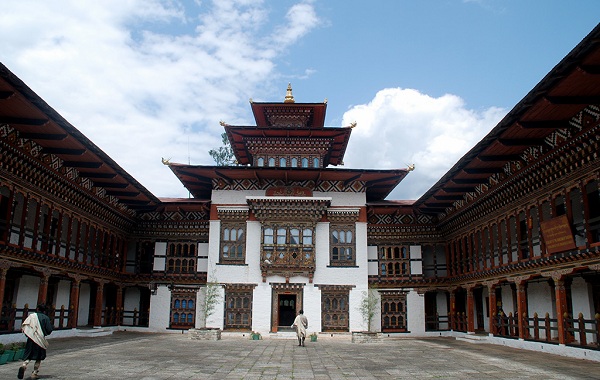
Trashiyangtse Dzong is one of the oldest Dzong in Bhutan with a history dating back t to the 9th century. It was previously known as Dongdi Dzong. Gonkar Gyal, grandson of lhasey Tshangma, who had established himself in Tshenkharla, built Dongdi Dzong. The people in the locals invited him. He accepted the offer and built Dongdi Dzong. However, Dongdi Dzong was abandoned and fell into ruins when the Tibetans attacked.In the 15th century, Tertn Pema Lingpa chanced upon the ruin during one of his visit and decided to rebuild it, renaming it Trashiyantse Dzong (the fortress of the auspicious fortune). In the 17th century, the ruler of Trashoyangtse, King Jidra, surrendered to the Tronsa Penlop Chogyal Minjur Tempa who was on a quest to unite the six eastern regions.
Legend of Chuchuzhey
This legend tells the story of how Chuchizhey (Avaloketeshvara or eleven-faced god of compassion) came to be in the Dzong. In the past, an old lady by the name of Shali Teng lived a few kilometers north of the Dzong. She left her home every day to collect firewood. One day, she heard whispers coming from beside a cypress tree. She ignored the sound, thinking some men were teasing her. On her way back she hear the same noise. On a closer look she found the statues of Chuchizhey, Jampelyang (Manjushiri) and a stupa. She asked to herself, “Who has left them here?” The Chuchuzhey replied, “No one brought us here, we flew from Lhasa, Tibet.”
The lady brought the statue home and she began to become richer day by day. Suspicious of her growing wealth, a local landlord peeped through her window and saw the statues and stupa. He snatched the statues and the lady reported the matter to the King. The King ordered the statues and stupa to be brought to the Dzong. The statues have remained in the Dzong since then.
Since then a few incidents surrounding the statues have increased locals’ belief on them. As the fame of the statue spread, a Bumthang chieftain came and grabbed the statues to be brought to his own town. Upon arrival, the weather turned bad, the chieftain fell sick and items on altar always appeared thrown around. The chieftain consulted the Zhabdrung who said that something new has been brought and kept on the altar. The chieftain immediately returned the statues.
On another incident, the statue went missing when an earthquake almost fell the entire Dzong. The locals found the statues in a cave and the statue spoke: ‘I’m fine here in the cave.” The Dzong also has a Dam Lung (subduing boulder), which can be seen on the wall at the main entrance of the Dzong. Oral accounts state that an evil in Dongdichu was harming people. Terton Pema Lingpa threw a boulder at the evil and subdued it. Further in the village of Pemaling, once can still see the walls of the hermitage where Pema lingpa meditated.
Trashiyangtse Dzong was renovated and sanctified with the sacred Rabney (consecration) ceremony in 2005 by His Holiness the Je Khenpo Trulku Jigme Choeda. Dongdi Tshechu is performed every on the 15th and 16th days of the 8th month of the Bhutanese Calendar.
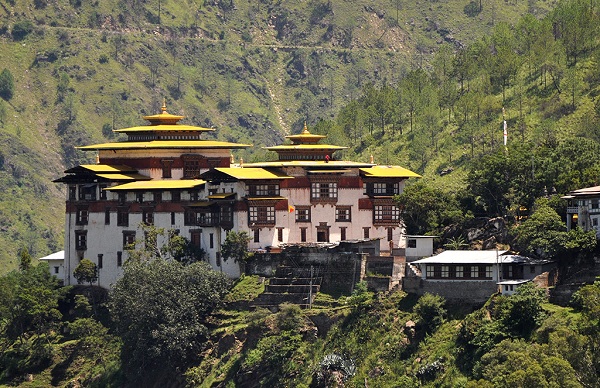
Trashigang Dzong is one of the most strategically placed Dzong in Bhutan. It is situated in the ledge of a mountain with steep cliffs on the three sides overlooking the Dangmechhu River. Hence, the Dzong is only accessible from the North. Zhabdrung Ngawang Namgyal prophesied the founding of the Trashigang Dzong. He directed Trongsa Penlop, Chhogyal Minjur Tempa, to subdue the local chieftains and build a Dzong in order to spread the Drukpa rule.
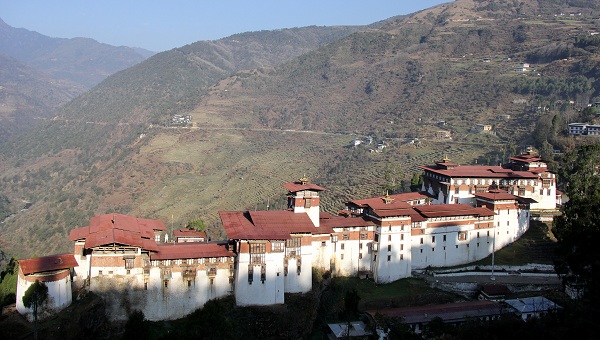
The Trongsa Dzong literally means the Dzong on the tip of a Dungkhar (of the never changing country of Druk and the everlasting Dharm). Trongsa Dzong is situated overlooking the Mangdechhu River.The Trongsa Dzong literally means the Dzong on the tip of a Dungkhar (of the never changing country of Druk and the everlasting Dharm). Trongsa Dzong is situated overlooking the Mangdechhu River. Trongsa Dzong was founded by Yingzin Ngagi Wangchuk, a descendant of Ngawang Chogyal and a revered follower of Kuenkhen Pema Karpo. In 1541, he meditated at the village of Yueli in Trongsa, a few kilometers from the present Dzong. During the meditation, he saw lighted butter lamp below the ridge at the present Goenkhang, which houses the guardian deities Palden Lhamo (Mahakali) and Yeshey Goenpo (Mahakali). Considering the place to be sacred, he built mediation quarters. Once during his meditation in the new quarter, the deity Palden Lhamo appeared and prophesied that this place would play an important role in spreading the teachings of Buddha. After this incident, Yingzin Ngagi Wangchuk constructed a small temple and named it Mondrupley. Over the years, his disciples built many smaller meditation centers near the Mondrupley temple, which soon began to resemble a small village. The people of Yueli names this new village Trong-sar (new village).
Considering the place to be sacred, he built mediation quarters. Once during his meditation in the new quarter, the deity Palden Lhamo appeared and prophesied that this place would play an important role in spreading the teachings of Buddha. After this incident, Yingzin Ngagi Wangchuk constructed a small temple and named it Mondrupley. Over the years, his disciples built many smaller meditation centers near the Mondrupley temple, which soon began to resemble a small village. The people of Yueli names this new village Trong-sar (new village).
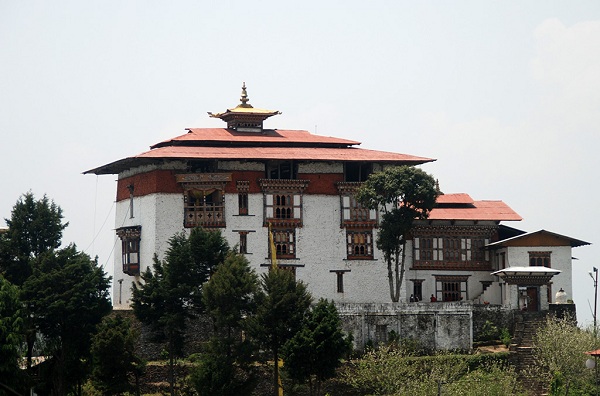
Lama Zhang Dorje Drakpa who lived in the 12th century founded the Zhemgang dzong. Lama Zhang Dorje Drakpa, a renowned scholar-sage of Drukpa kgyu school of Buddhism, originated from Tibet and travel to present Zhemgang in 1163. Lm Zhang set up a hermitage in on the present site of the Dzong and settled there for many years. In 1655 CE, a one-storied Dzong was built on the hermitage to defend the land against invaders led by Choestse Penlop.Khenrig Namsung is the ancient name of Zhemgang Dzongkag. It literally means the three divisions of Kheng: Upper (Chikhor), Middle (Namkor), and Lower (Tamachok) Kheng.Popular legend described the death of Lam Dzang. Through yogic power, lama Dzong realized that his brother, a courtier of the powerful Khaling overlord, Lango, was in serious danger. Lango was a sadistic creature, with a human body and the head of a bull, who delighted in eating human flesh.
Lama Dzang devised a scheme to save his brother without offending Lango. He wrote a letter to Lango saying that his health is waning and would like to have his brother by his side. On another letter to his brother, he warned his impeding danger. Unfortunately, the letters were mistakenly delivered. Upon reading the letter meant for Lama Zhang’s brother, Lango was enraged and devour Lama Zhang’s brother. Lango also sent a courtier to kill the Lama.
The villagers were also forced to help the courtier. They stormed the hermitage and run directly into the overwhelming powers of the Lama. Using his yogic powers, he flew to Wamdokpa. The villagers followed in pursuit but were unable to kill him. Oberving the plight of his pursuers, pity swayed Lama Zhang into making his final decision. Lama Zhang surrendered his life, strangely instructing them to kill him by stuffing a ceremonial scarf down his throat. Today, the village where Lama Zhang was killed is known as Trong, an honorific word for kill.
The annual Tshechu of Zhemgang was introduced after the inception of the Rabdey in 1966. It is held for five days, from the 7th to 11th of the 2nd Bhutanese month.
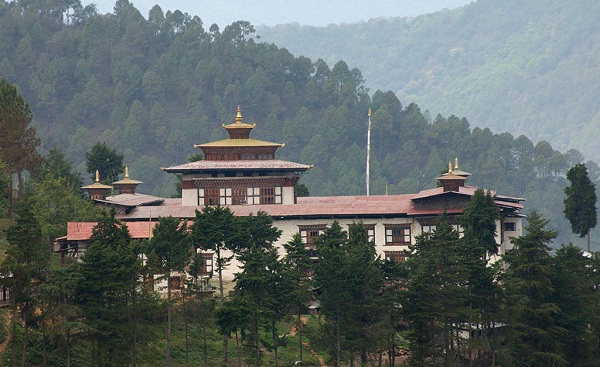
The Bhutanese equivalent of Count Dracula’s castle, the Dzong is pretty much avoided by the locals today. There is no written history of the Dzong. Oral account believes that a king named Karpo Dung who invited a famous architect from Paro by the name of Zochhen Bala to design and built the fortress commissioned the Dzong. The architect is believed to have come across a white stone, shaped like a bowl, on a mound just above the Kurichhu. He called the place Zhongkar (Zhong = bowl and Kar = White) and decided to build the fortress there.On the way to construct the Dzong, the Tsen (cliff deity) is believed to have sent two of his deputies to kill the architect. Bala miraculously survived the encounter. On arrival, Bala took seven days to create a model of the Dzong from stems of the Artemisia (Khnpashing) plant. Bala built a magnificent Dzong. Fearing that Bala would build a better dzong in future decided to but off Bala’s hands during the farewell ceremony. Some account believes that Bala was thrown in to the Kurichu and drowned.
As he was dying, Zochen Bala made a wish that subsequent King would face the same pain as him and that his dynasty would be wiped out. He also made a wish to be reborn as an evil in the court of the Tsen of Golongfrak that would forever haunt the Dzong and adjoining area. Locals believe that Bala was reborn as a giant snake that guard the Dzong and killed King’s horses once a night.
The King sought the help of religious master of that time, Paseling Trulku, who journeyed to the Dzong. Trulku entered into a retreat and instructed not to be disturbed. However the King who was growing suspicious, instructed his chamberlain to spy on Trulku on the sixth day. Upon finding this distrust, Trulku informed the King that the Dzong couldn’t be saved, as the snake, which the chamberlain saw submitting to Trulku, cannot be completely subdued. The King offered the offered Trulku a hundred cows and the pastureland around the Yundhiridrang. Till today, the land is still owned by the descendant of Trul
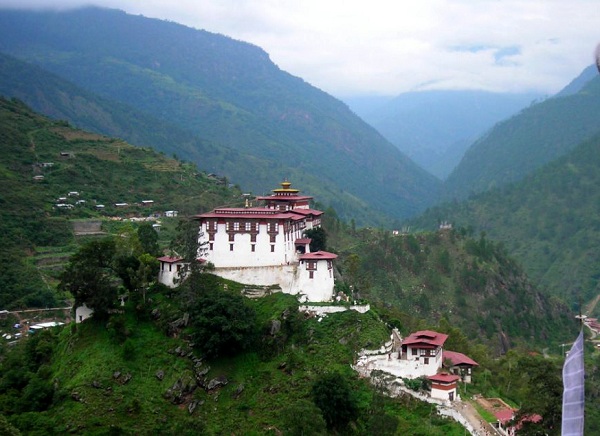
The Luntse Dzong was originally a temple built on the site where Ngagi Wangchuk meditated in 1551. The temple was known as Kurtoe Lhuntse Phodrang. For many years, the Lama resided here and later went to Timula, where he established his summer seat.According to another count, Ngagi Wangchuk was meditating in Timula. He arrived at present location of Lhuntse Dzong looking for a winter seat. A deity appeared before him in the form of a white bleating goat. The bleat was taken as an auspicious sign and he built a temple in 1552. The temple was named Leyley Dzong, The Fortress of the Goat.
The bronze statue of Tshepame is the most sacred artifact in Lhuntse Dzong. The statue believed to be found by a fisherman who decided to keep it in Kiling Lhaksha. However, the image is found to have escaped the place on more than one occasion until an iron curtain is installed on the window. However, the image tore a gap on the chain and escaped. Killing Gonpo, the Lhakshang deity, is believed to have thrown a stone on the image while it was escaping, breaking the centre of the crown, Rignga. A woman who was cutting grass in the paddy fields found the image. She heard the word atsa, an expression of pain, and found that she has sliced the left thumb of the image. The statue was then returned to the Dzong. Locals believe that smoke rises from the grove in the eighth month, prior to the celebrated “blessed rainy day.”
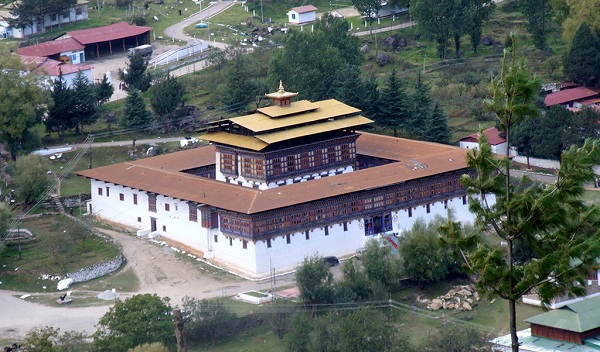
The Haa Dzong was started in 1895 after the appointment of the first Drungpa. The Dzong was intended to be a centre to address the affairs of the people and a defense against Tibetan attack given its proximity to the border. Oral tradition believes that the Dzong was built to hold back the evil influences of the serpent deities on the lives of the people and their livestock. The local believes that there are 108 serpent deities around the area. Some of the Chorpens (stupas), which were built in order to appease these deities, can still be found.Haa Dzong was heavily damaged in a fire in 1913. Gongzim Ugyen Dorje started the building of new one on the same year. The second Dzong was named Dzongsar Wangchuklo Dzong. The prefix ‘sar’ which means new was added to the word Dzong.
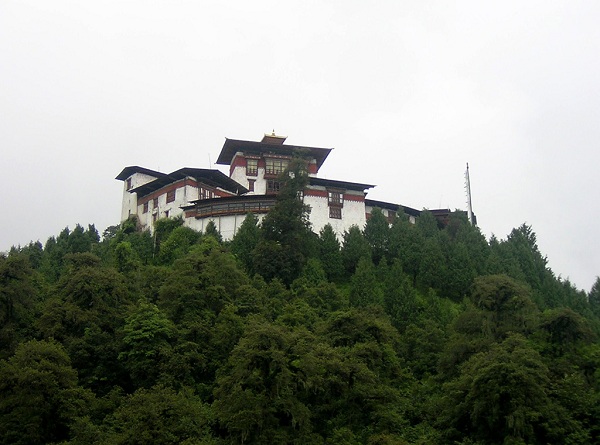
Gasa Dzong is the administrative headquarter of Gasa Dzongkhag. The Dzong was named after its protector Trashi Thongmoen. Legend believes that Zhabdrung who was greeted by deity of Gasa when he made his way to Bhutan gave the name of the deity. The Dzong was often called Garsa Dzong, which means “the land of Black Smith.” It refers to the Tekhungpa who was skilled in iron works and worked in the area.Every year in the last week of the 10th month Bhutanese calendar, Drapai Loan (head of the lexicography division of the monastic body) led a contingent of monastic body to make the annual offerings to the deities. Gun salutation is performed on the 29th day to honor Mahakala.
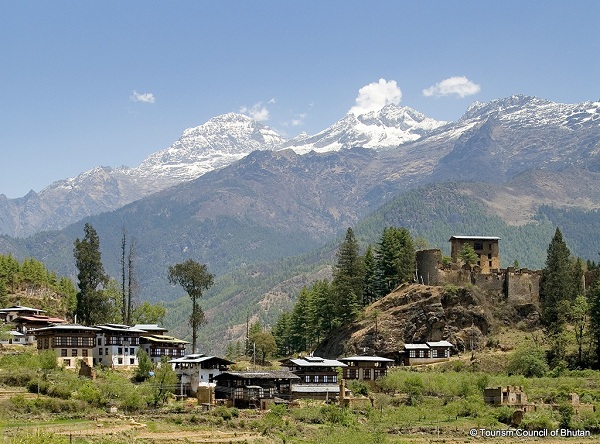
Located in the Phondey Village in Paro, the Dzong is built on the summit of a rocky hill that rises steep on three sides. The Dzong was built to guard the approach to Paro Valley from Tibet and is only accessible from one side, which is defended by 3 prominent towers.Probably it was Tenzin Drukdra built the Dzong in 1649 at the behest of Shabdrung Ngawang Namgyal to commemorate victory over an invasion from Tibet. In the early 1950s Drukgyal Dzong was almost completely destroyed by fire.
Drukgyal Dzong means the “fortress of the victorious Drukpas” and is one of the four principal Dra Dzongs (defense fortress). The other defense fortresses are the Gasa Trashi Thongmon Dzong, Haa Damthang Dzong and Lingzhi Dzong. Different historical accounts diverge as to the founder of Drukgyal Dzong.
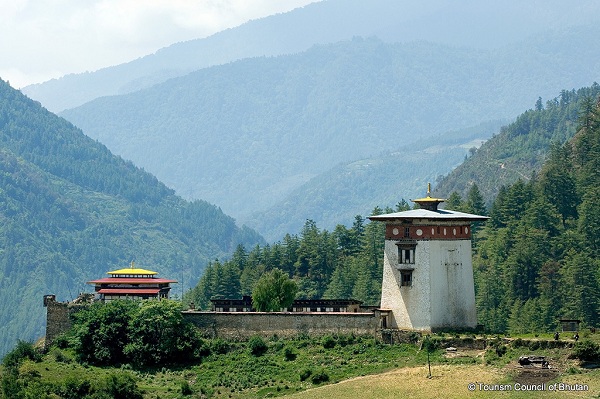
Dogar Dobji Zhong is considered to be the first model Dzong in Bhutan. The name Dogar, which means white bolder, is a reference to the “Five White Bolders” in the village of Dogar. The Dzong as built in 1531 by Ngawang Chogyal, the brother of Chojie Drukpa kuenley, who is popularly known as the “Divine Madman”. Legend has it that Ngawang Chogyal has followed the spring originating below the throne of jetsun Milarepa in Tibet. The source of the spring was found to be a rock located on the current location of Dobji Dzong, which was then chosen for its religious significance.The mentioned spring is still visible today. However, a massive earthquake destroyed much of the Dzong. The remaining central tower was believed to have survived because of a Terma statue (the treasure statue of Guru Langdarchen). The statue is believed to have spoken to Tibetan King Langdarm, who was notorious for secreting Buddhist monasteries, when he attempted to destroyed the statues with a hammer.
Today, Dobji Dzong is home to many religious relics; statues of Jetsun Milarepa, Guru Langdarchen, Dungsay dewa Zangpo (son of Dupthob Chagzampa) and Ngawang Chogyal. The Ghokhang houses the Goem-Chamdal Sum: Mahakala, Mahakali and the Raven Crown.
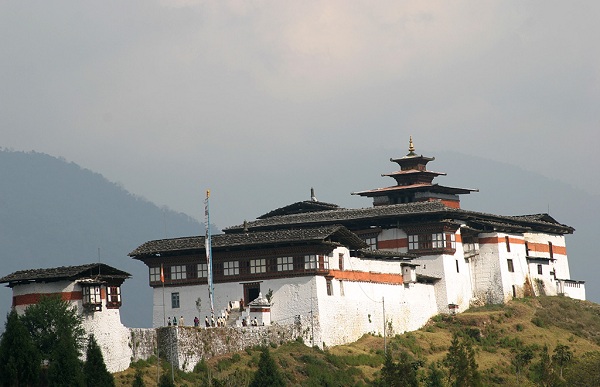
The name Daga Dzong is derived from two sources; Darkala, which comes from the province’s guardian deity Jomo Darkala and Darkanang (The Realm of White Prayer Flags) from Dudjom Jigdrol Yeshey Dorji, a great Buddhist master. The Daga Dzong was traditionally the stronghold of the Daga Penlop who held the rank of cabinet minister under the Desi (temporal ruler) system og government introduced by Zhabdrung Ngawang Namgyel in 1651.Druk Namgyel who was under the order of Zhabdrung Ngawang Namgyel to pacify the area and defend it from the southern states, present day Assam and West Bengal of India built the Dzong. Due to its defensive nature, the Dzong occupies a ridge overlooking the valley. The dzong was completed within 2 years of first stone being laid.
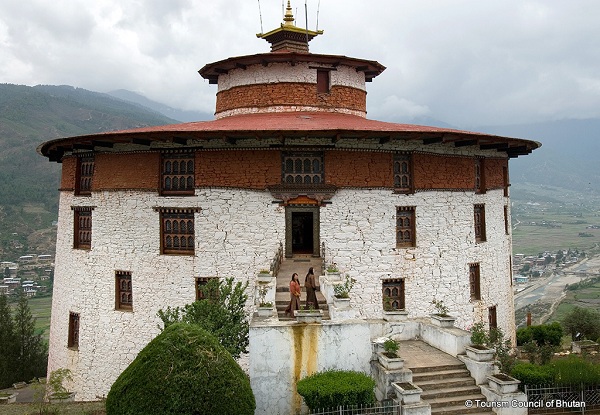
Taa Dzong (Ta = watch and Dzong = fortress) is located about five and a half kilometers from Tshondu Town and 500 feet from the Ringpung Dzong. It is built under the government of the the 2nd Desi, Ngoenpa Tenzin Dugda, in order to protect the Ringpung Dzong from the unceasing assaults from Tibet and India.An underground passage is believed to connect the tower and Pachhu River. This is used to supply the tower with water during war. However, the passage has collapsed.
The Taa Dzong was uninhabited for a long period of time. The state of the Dzong was so poor that it was on the brink of collapsing. The Dzong was later renovated by the order of the Father of Modern Bhutan, the third king, Jigme Dorji Wangchuck.
Even though the Dzong was built with just stone and wood without the aid of any nail, the structure of the Dzong is very strong. The Dzong survived the 1714 earthquake that lasted for 15 days while other Dzongs didn’t and it survived the earthquake in 1896. Strangely, there is no record to who is the builder and architect of the Dzong.
In 1967, the 3rd King, Jigme Dorji Wangchuck, inaugurated the Dzong as the Textile Museum.
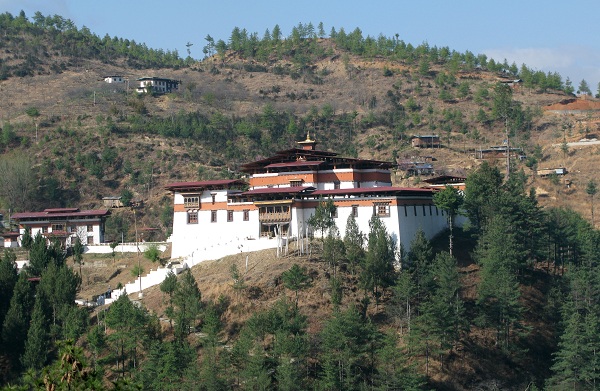
Strategically built on a projecting ridge with deep gullies, the Simtokha Dzong overlooks and commands the entire Thimphu Valley.Zhabdrung Ngawang Namgyel was one of the greatest builders of Dzongs in Bhutan. To consolidate his newly acquired domain in western Bhutan and to defend himself from both the internal foes and external enemies he started constructing Dzongs, beginning with the Simtokha Dzongs.
The present place where the Dzongs stands is the boundary between common to three western regions: Sha (wangduephodrang), Wng (Thimphu) and Pa (Paro). The intersection was marked with three stones which belong to the people of Punakha, Thimphu and Paro. Surrounded by these three stones was a piece of land known as Sem-tokha or Sem-dokha with a temple built on it. This temple was later gifted to Zhabdrung by Lama Pangka Shong. History says that a Tibetan lama Zhang has prophesied that Zhabdrung Ngawang Namgyel would build a Dzong at the junction of three western lands. To fulfill the prophecy and honor the offer of Lama Panka Shons, Zhbdrung decided to build the Dzong.
The area was inhibited by many demons, and legend has it that the site where Zhabdrung decided to build the Dzong was occupied by a demon that would harm travelers who often stayed during the night. Zhabdrung visited the place and subdues the demon, banishing her into the rock on the hill where the present Dzong is located. The Dzong was constructed enclosing the rock, to ensure the continuing imprisonment of the demon. Hence the dzong derived its name as Simtokha, from the word sunmo (demon), do (stomach) and kha (on) – the Dzong on top of the demon’s stomach.
Today, The Dzong houses the head of Lama’s chamber, the Enemy Dzong (a chamber to store weapons), a storeroom, and the monastic school. 500 meters above the Dzong one can see the ruins of the Ta dzong (watch tower). To the left of the Dzong, about 100 meters away, is a water fortress (Chu Dzong) which today is used as a prayer hall by the students. In front of the Dzong, to the right is a crematorium. At the junction of the highway there is a Chorten which dates back to Zhabdrung’s time.
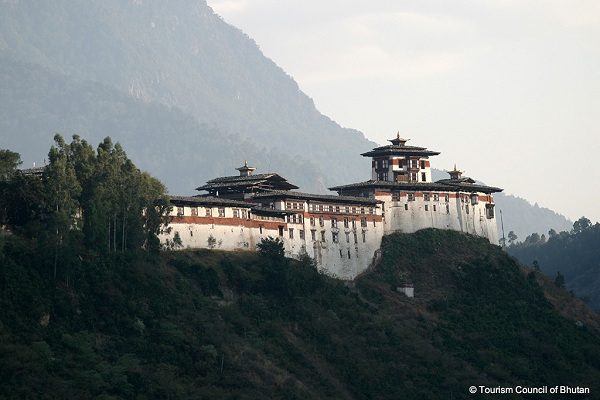
Zhabdrung Ngawang Namgyel was supposedly at Chimi Lhakhang in Punakha when he met a decrepit old man. He described a ridge in the present-day Wangdue Phodrang as a ’sleeping elephant’ and told Zhabdrung that he would unite the country by building a Dzong on the ’neck’ of the ridge. The Zhabdrung, surmising the old man to be Yeshey Gonpo (Mahakala), took his suggestion and sent forth a noble to study the area. As the emissary drew close to the area, he saw four raves circling above the ridge. Upon reaching the ridge, the birds flew in four directions. On returning to Chimi Lhakhang he made his report. Zhabdrung Ngawang Namgyel took this as a good omen and immediately set forth in 1638 to construct Dzong overlooking the convergence of the Dongchu and Punatshangchu.An interesting story connects the Dzong to the old cantilever bridge that once used to span the Punatsangchu. The bridge was built after the construction of the Dzong under the direction of a famed mason called Drakpa fromRinchengang village. As a safeguard against flash floods, a mandala dedicated to Mithugpa (Aksobya) was installed at the base of the bridge’s foundation. During the tenure of the 20th Wngzop Domchung a big flood washed way the entire bridge, but the base where the mandala was installed was left intact.
It is said that Dzongpon Domchung organized a tsechu in which the Doley Raksha dance, famed in the region for its aesthetic intricacies, was performed to attract the river spirit who was disrupting the reconstruction of the bridge. As the spirit stayed engrossed in the festivity, Domchung, with several hundred men, sneaked down the river and completed the bridge. The spirit unleashed many floods to bring down the bridge, but the Wangzop, true to his clever character, had a worked design into the foundation pillars to withstand the force of the water.
Wangdue Dzong has 14 temples, including Kunrey (assembly hall of monks). The Goenkhang has a figure of gonpo (Mahakala) carved on a stone slab. Wangdue Dzong was razed to the ground on 26 June 2012. It is believed that the fire is caused by electrical short circuit. Though most of the Dzong expect for one monastery was destroyed, religious and historical relic managed to be rescued by volunteers and care keepers. More information can be read on CNN.
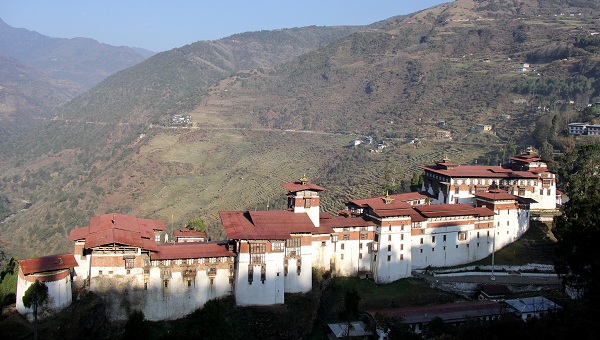
The Trongsa Dzong literally means the Dzong on the tip of a Dungkhar (of the never changing country of Druk and the everlasting Dharm). Trongsa Dzong is situated overlooking the Mangdechhu River.The Trongsa Dzong literally means the Dzong on the tip of a Dungkhar (of the never changing country of Druk and the everlasting Dharm). Trongsa Dzong is situated overlooking the Mangdechhu River. Trongsa Dzong was founded by Yingzin Ngagi Wangchuk, a descendant of Ngawang Chogyal and a revered follower of Kuenkhen Pema Karpo. In 1541, he meditated at the village of Yueli in Trongsa, a few kilometers from the present Dzong. During the meditation, he saw lighted butter lamp below the ridge at the present Goenkhang, which houses the guardian deities Palden Lhamo (Mahakali) and Yeshey Goenpo (Mahakali). Considering the place to be sacred, he built mediation quarters. Once during his meditation in the new quarter, the deity Palden Lhamo appeared and prophesied that this place would play an important role in spreading the teachings of Buddha. After this incident, Yingzin Ngagi Wangchuk constructed a small temple and named it Mondrupley. Over the years, his disciples built many smaller meditation centers near the Mondrupley temple, which soon began to resemble a small village. The people of Yueli names this new village Trong-sar (new village).
Considering the place to be sacred, he built mediation quarters. Once during his meditation in the new quarter, the deity Palden Lhamo appeared and prophesied that this place would play an important role in spreading the teachings of Buddha. After this incident, Yingzin Ngagi Wangchuk constructed a small temple and named it Mondrupley. Over the years, his disciples built many smaller meditation centers near the Mondrupley temple, which soon began to resemble a small village. The people of Yueli names this new village Trong-sar (new village).
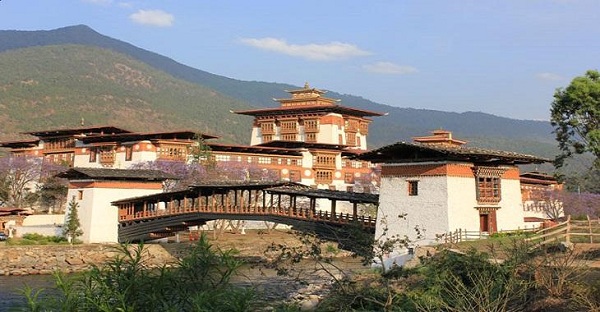
Zhabdrung Ngawang Namgyel, the founder of Bhutanese state, built Punakha Dzong in 1637. It was originally named Puntang Dechen Phodrang Dzong, which means the Palace of Great Bliss.Punakha Dong was built on the 8th day and 8th month of the Fire ox year in 1673. The Tibetan attacked the dzong in 1639 and 1644. The defenders successfully repelled the attacks. To commemorate the victory, a New Year festival was introduced and Yu Gyal Gonkhang Chen Mo, “the great shrine of the protective and victorious lord” was built.
The first King of modern Bhutan was crowned in Punakha Dzong. Punakha Dzong remained the centre of government until it was relocated to Thimphu. In 2011, the wedding of the 5th King was held in this fortress.
Best time to visit: May. Jacaranda flowers will be blooming in the courtyard of the fortress.
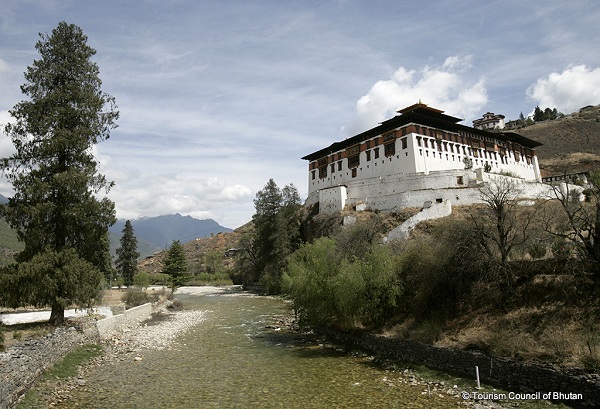
Paro Dzong is the administrative seat of the district of Paro. The Paro Dzong was built in 1644 under the order of Zhabdrung Ngawang Namgyal. Paro Dzong full name is Rinpung Dzong, which means ’the fortress of the heap of jewels.” Gyelchock founded Paro Dzong.Gyelchock and his brother, Gyelzom, is descendant of Phajo Drugom Zhigpo, the founder of the Drukpa Kagyupa School in Bhutan. Gyelzom established the Gangtakha Monastery while Gyelchock travelled to Tibet to study theology.
Upon Gyelchock’s return from Tibet, he was not respected by the community and denounced by this brother because he is considered a pauper or beggar. Gyelchock moved to Humrelkha, a place that took its name from the guardian deity of Paro, Humrel Gyalpo. He built a five-storied tower, which would later become the Paro Dzong. It is believed that the base of the cliff was the La Tsho (soul lake) of the deity Jag Wog Nep. In 1644, Gyelchock, “The Lord of Humrel”, relinquished his small fort to zhabdrung Ngawang Namgyel
In 1906, during the time of of the 23rd Penlop Dawa Penjor, the Dzong was almost burnt almost to the ground. All-important relics were lost to the fire and nothing could be salvaged except for the Thongdrol, a 20 x 20 metre-wide Thangka. The Thangka is displayed annually during Paro Tshechu.
The annual Paro Tshechu is held from the 9th till the 15th of the 2nd month every year. Tenzin Rabgy first introduced this ceremony in 1678. The highlight of the Tshechu is the Thongdol, which is believed to deliver from all sins. The Thongdol was built by Lama Nawang and saved from the fire of 1906. Zhabdrung Nawang Namgyal and Karma Rigzin Nyingpo, the reincarnation of Terteon Sangay Lingpa, consecrated the Dzong.
Sources : various from web



